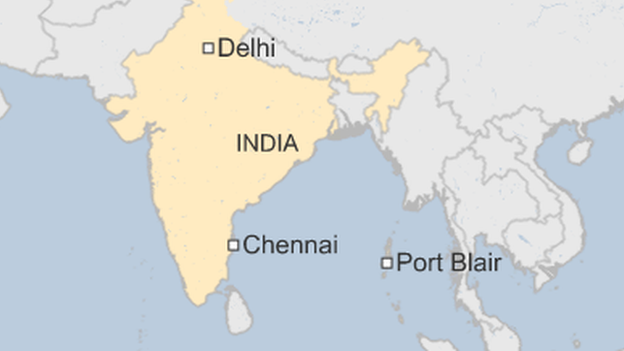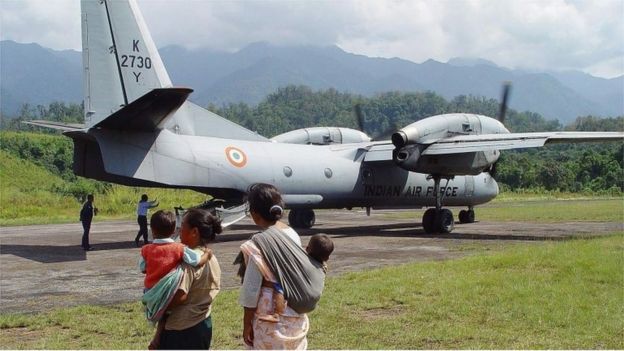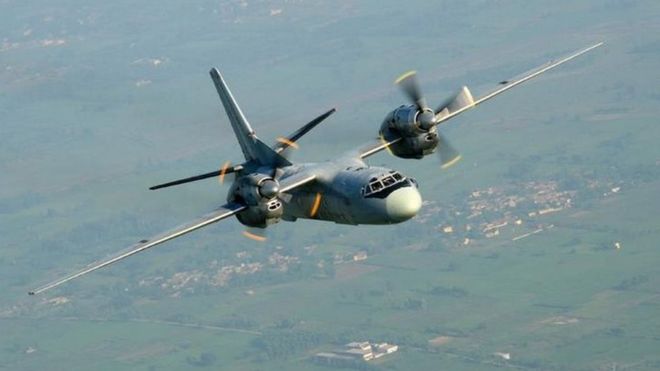On 22 July, an Indian military plane with 29 people on board, including six crew members, went missing over the Bay of Bengal.
More than three weeks and a massive search operation later, there is no trace of the plane.
Defence Minister Manohar Parrikar says experts he’s spoken to are “puzzled by the sudden disappearance” of the plane.
So what do we know about the plane so far?
The Antonov-32 transport aircraft took off from the southern city of Chennai (Madras) at 08:30 local time (03:00 GMT), for a three-hour flight to Port Blair, in the eastern archipelago of Andaman and Nicobar.
‘Just disappeared’
The plane climbed to a cruising altitude of 23,000ft (7,010m) over the sea before disappearing from air traffic control screens at approximately 09:12 local time, some 270km (167 miles) east of Chennai.
Seven to eight minutes before the aircraft vanished, the pilot said he was changing course to the right to avoid a thundershower cloud.
Records show it descended “very fast” from its cruising height and vanished from the radar. There was no distress call from the cockpit.
“It just disappeared – no SOS, no transmission at any frequency. That is the worrying part,” says Mr Parrikar.
When it disappeared, the plane was on the fringes of an area of around 150-200 nautical miles where there was no radar coverage. Such “blind spots” over remote areas of land and sea are not uncommon.


The ongoing deep sea hunt for the missing plane, say officials, is possibly the biggest – and most arduous – in India’s aviation history.
Air force and coast guard planes have flown more than 1,000 hours covering 360 nautical miles trying to locate debris.
Some some 30 ships – including two sophisticated ocean research vehicles loaned from India’s top oceanographic institute and the Geological Survey of India – and submarines have combed more than 430 sq km in waters up to 4km deep. (This is around the same depth at which the flight data recorders from Air France Airbus plane that crashed into the Atlantic in 2009 were found after two years of search.)
‘Needle in a haystack’
All they have found are some 30 floating objects – mainly deep sea detritus and nothing remotely associated with the missing plane. Two dozen electronic transmissions picked up in the area came from other sources. Satellites have drawn a blank in picking up any signals from the plane.
The missing Antonov-32 is part of the air force’s 100 or so strong fleet of the Russian-made aircraft, described as the workhorse of the force. These planes were inducted into the force between 1984 and 1991. Air force officers point to the reliability of the aircraft, saying it has been landing regularly at Daulat Beg Oldi, the world’s highest airstrip, located in Ladakh.
Mr Parrikar says the missing plane had been upgraded, and flown for nearly 179 hours after that. The pilot had flown more than 500 hours on this route.
The plane was equipped with an emergency locator transmitter, a portable emergency locator transmitter which pilots activate in the cockpit and personal locator beacons, that are attached to life vests and dinghies. “We have been looking from signals from all three,” says an official. “But we have received nothing.”

But the aircraft was missing something crucial: the underwater locator beacons, or pingers, which are fitted to aviation flight recorders – cockpit voice recorder and flight data recorder – and transmit signals at low-level frequencies from deep under water. They have a battery life of 30 days.
This appears to be a big chink in the armour of India’s trusted transporter – none of the Antonov-32s were equipped with them. Since the plane vanished, the air force has been scrambling to put such beacons on these planes flying over the sea. Also, according to one report, the plane “reported three snags” in less than two weeks last month.
In the end, still nobody knows what happened to the plane. Did it fall out of air? Did it plunge into the sea? The minister believes there is very little possibility of sabotage.
But there’s no reason to assume this will remain a mystery. The debris of a Dornier reconnaissance aircraft from the Indian Coast Guard which disappeared with two pilots and a navigator, on 8 June 2015 was recovered more than a month laterafter a vast search operation.
“It is like searching for a needle in a haystack. We are still hoping for a miracle,” an air force official told me.

Normal aircraft tracking

Air traffic control – standard international practice is to monitor airspace using two radar systems: primary and secondary.
Primary radar -based on the earliest form of radar developed in the 1930s, detects and measures the approximate position of aircraft using reflected radio signals. It does this whether or not the subject wants to be tracked. Secondary radar, which relies on targets being equipped with a transponder, also requests additional information from the aircraft – such as its identity and altitude.
All commercial aircraft are equipped with transponders (an abbreviation of “transmitter responder”), which automatically transmit a unique four-digit code when they receive a radio signal sent by radar.
The code gives the plane’s identity and radar stations go on to establish speed and direction by monitoring successive transmissions. This flight data is then relayed to air traffic controllers.
However, once an aircraft is more than 240km (150 miles) out to sea, radar coverage fades and air crew keep in touch with air traffic control and other aircraft using high-frequency radio.
By Soutik Biswas







